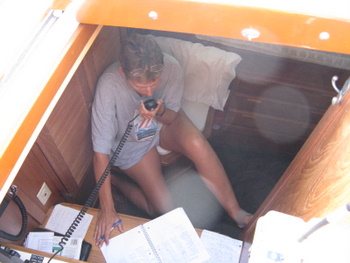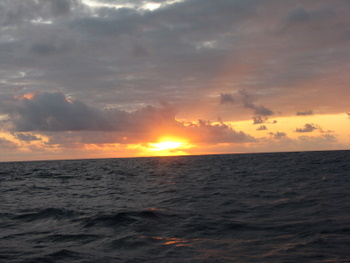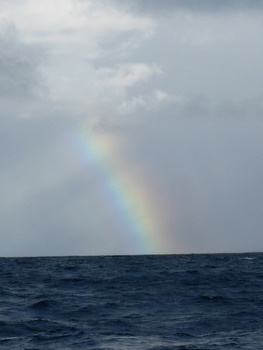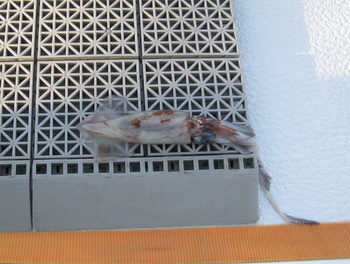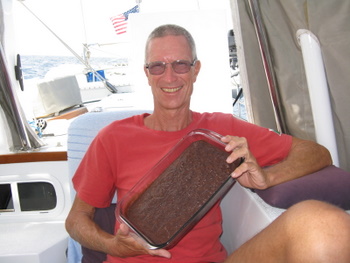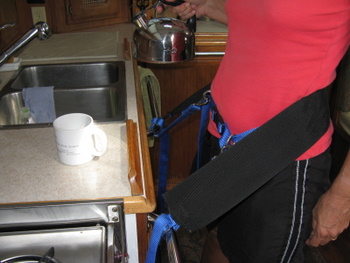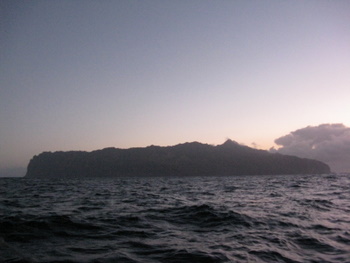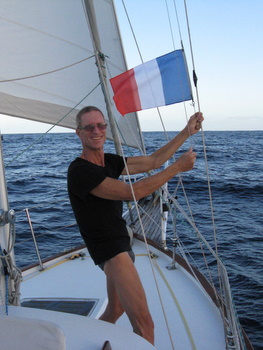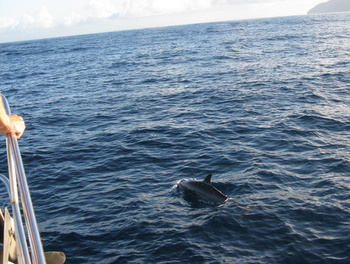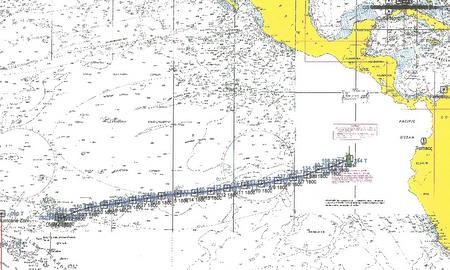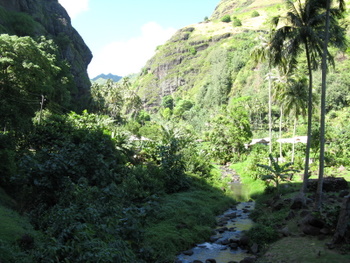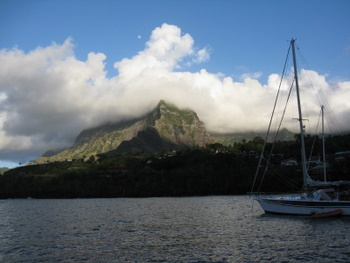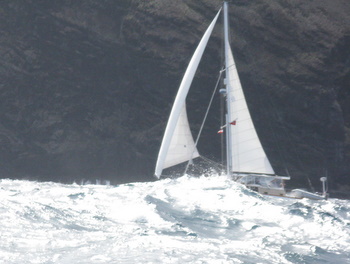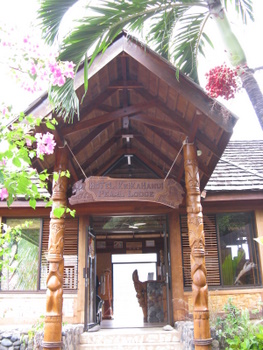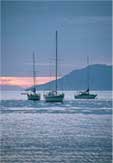
Current Location
(enter callsign KG6NNZ)
Logbook: South Pacific Passage and Marquesas Islands, June to July 2010
Passage from Galapagos to Marquesas Islands (June 3-24, 2933 nm, 20 days and 18 hours). The passage to the South Pacific was one we had pondered and anticipated for several years. We have a number of friends who went before us, and we read their emails and listened to their experiences with great interest. And now it was our turn. The passage is not reputed to be a particularly difficult one; it's just long. Most boats make the passage from the Galapagos to the Marquesas in three to four weeks. We had just done our longest passage from Panama to the Galapagos (8 days), and prior to that our longest was about 4½ days, so this was significantly longer. The really nice aspect of this passage is that one sails with the tradewinds - winds that are fairly consistent in strength and direction. Although the tradewinds were not right at our doorstep in the Galapagos, we didn't have to go far to get to them.
We departed from Isla Isabela in the Galapagos Islands just before sunset on June 3. An hour out of port, we had light winds (6-7 knots) on our beam, and we turned off the engine and sailed slowly with fairly calm seas. We sailed in light winds for 48 hours, but on our second night out, the wind died completely, and we turned on the engine. For the next few days, we had light but sail-able winds during the day (a couple of days with good spinnaker runs), but no wind at night, so we motored. On our fifth day, the winds got a bit stronger (8-10 knots), and they didn't die out that night - we had reached the trades! The engine stayed off for the next 16 days.
It took us a few days, but we eventually settled into a routine that worked well for us. In the past, when we had done multi-day passages, we stood four-hour watches - e.g. Jan slept from 8 p.m. to midnight while Rich stood watch, and Rich slept from midnight to 4 a.m. while Jan stood watch, and we continued alternating every four hours around the clock, napping on our off-watch time in order to get enough sleep. For some reason, this schedule wasn't working for us this time. Jan was feeling especially sleep deprived and was having a hard time staying alert on her midnight to 4 a.m. watch. One night, Rich let Jan sleep a couple extra hours, and that made a huge difference. So, we ended up changing our night-watch schedule to give both of us longer sleep times - Jan slept from 8 p.m. to 2 a.m. while Rich stood watch, and then Jan stood watch from 2 a.m. to 8 a.m. while Rich slept. We still both required some nap time during the day, but the longer sleep period during the night worked really well.
While on watch offshore, we normally take a look around the boat every 15 minutes or so to see if there is any traffic nearby. If there is, we'll keep a closer watch to make sure we pass safely. Boat traffic on this passage was pretty slim, and we have to admit our vigilance slipped a bit at times. When we first left the Galapagos, we were in sight of another sailboat that left a few hours ahead of us. But we lost sight of him on the third day, and then we went for 10 days without seeing another boat. We never saw any cargo ships or other sailboats on the entire passage. On two occasions, we saw small fleets of commercial fishing vessels (two to three large boats traveling together), but that was it. Since there was so little boat traffic, we had time on our hands. Rich was happy to spend most of his free time reading, and he plowed through close to a dozen books. Jan enjoys reading, but if she's tired, it will put her to sleep, so although she read a couple of books on the passage, she needed to find other activities to keep her busy. The iPod provided her lots of entertainment. In addition to music, she listened to a couple of audio books and Coffee Break French podcasts - French lessons in preparation for our visit to French Polynesia. She also completed numerous crossword and sudoku puzzles, watched a couple of DVD movies and worked on the website if the seas weren't too rough.
| We also had a radio schedule to keep. While underway from Panama to the Galapagos Islands, Jan was a Net Controller a couple days per week on the Pan Pacific Net, which is basically a daily meeting of boats on the SSB radio. Through that, we kept in contact with boats that were on that passage. There was no established Net from the Galapagos to the Marquesas, and crews on several boats approached Jan about organizing one so we could keep in touch on this next passage. It was a fairly easy task - we picked radio frequencies, established check-in times and passed the word. Jan asked for volunteers to serve as Net Controllers, and she quickly had enough folks to fill the schedule - each person took one day per week. Boats left the Galapagos at different times - the first boats started leaving in mid-May, we left in early June, and several more boats left after us. We met and checked in with one another on the radio twice daily - once in the morning, and once in the evening. Each boat reported its position (latitude/longitude), wind and sea conditions and let us know if all was well. We advised each other of sightings of weather buoys or fishing vessels. Word of the "Pacific Puddle Jump" Net spread, and by the time we got underway, there were already about 25 boats checking in. It was a very international group - boats from the USA, Canada, England, Holland, Austria, Germany, El Salvador, Switzerland, Australia and New Zealand. As the first boats to depart arrived at their destinations, Net Controllers passed on their jobs to those boats that departed later and were still underway. Several weeks after we arrived in the Marquesas, there were still a few boats making this passage and the Pacific Puddle Jump Net was still going on (although the remaining boats had renamed it the "South Pacific Stragglers Net"). |
|
The Net ends up being mostly a social thing. It's kind of nice to have someone else to talk to on the radio, and especially when you're at sea for a few weeks! However, the true purpose is safety - making sure everyone is OK and rendering assistance if it's not. Before calling for check-ins from vessels underway, the Net Controller always calls for "emergency, medical or priority" traffic. One evening, about 10 days after we started the Net, one of the boats had a medical situation that required assistance. Flo on Flina (an Austrian boat) had cut his hand, and the cut became infected. He started taking an antibiotic, but it wasn't helping, and he had red streaks running up his arm. Flo called on the radio - very concerned about blood poisoning, and Flina was literally in the middle of the Pacific - two weeks from making landfall at the Marquesas. Normally, there's an MD or two in the cruising group, but not so this time. We were still at anchor in the Galapagos and listening to the Net. Keith on Atalanta (an American boat) was in our same anchorage, and he is a retired veterinarian. We called Keith on the VHF, and he got on the SSB radio and talked to Flo about which antibiotic he had tried and what others he had on board. (Most cruising boats carry a few different antibiotics in our medical kits.) Keith recommended changing to a different antibiotic, which Flo did, and 24 hours later, he showed improvement. Next problem - Flo had a few days' supply of this antibiotic on board, but not enough to get him to his destination. Sara II (a British boat) was about 200 miles away from him and had a supply of the antibiotic on board. A few days later, Flina and Sara II rendezvoused in the middle of the Pacific, and Sara II delivered to Flo a sufficient supply of the antibiotic to get him to the Marquesas. Mission accomplished! One last point of interest - on the night when we first got the call asking for medical assistance, before we reached the veterinarian, we contacted another Ham Radio Net - the Maritime Mobile Net - to let them know that we had a medical situation that required assistance. They contacted the U.S. Coast Guard, who then called in to our "Puddle Jump" Net to see if they could render aid. If needed, they were prepared to arrange an evacuation for the crew member, but fortunately it never came to that. Several boats were involved in the effort to help our fellow cruiser, and it was incredible to see this group come together and take action.
Overall, our passage went about as well as one could expect. We arrived at our destination safe and sound, sooner than anticipated, and we had no equipment failures. Our third crew member - the autopilot - steered the entire way, and we toasted it and kissed it when we arrived. Rich actually had to steer for 30-45 minutes each day while Jan sent and received email on our SSB radio because the autopilot interfered with the transmission. Steering in strong winds and big seas is not easy - Rich was always very happy when the email transmission was done, and he could turn the autopilot back on.
Our average speed over the entire trip was 5.9 knots. Some of that speed came from a current that gave us a push the entire way - 1½ knots at the start of the trip, but down to a ½ knot by the end. Each evening at 6 p.m. we calculated our distance traveled for the past 24 hours. On average, we made 141.3 nm each day. Day # 9 was our best 24 hour run of 172 nm (an average speed of 7.2 knots that day!). Day # 2 was our slowest day when we covered only 81 nm (average speed of 3.4 knots). We had a total of 7 days with over 150 nm.
The first ten days of the trip were a beam reach, and the last ten days, we sailed wing-and-wing with the wind on our port quarter. Mostly the winds blew in the high teens and low 20's, and the seas were somewhat rough, running about 8 feet, with a mixed swell from the southeast and the south. It wasn't a comfortable ride, but we adapted. We had a few days with 20-25 knots of wind, and one day with 25-30 knots of wind and 15-20 foot seas - that was not fun! We started our passage when the moon was waning, and the combination of that and cloud cover at night made for very dark nights. We had mostly sunny days, which was great for our solar power, but in the afternoon, the clouds would start to gather, and for about half the passage, squalls would hit after dark. Most of the squalls weren't too bad - about 25 knots of wind maximum - but we had a few that gusted over 30 knots, and those are especially not fun when they hit at night! The squally weather brought lots of rainbows - we sometimes saw two or three a day. Toward the end of the trip, the night skies cleared up, and the moon was waxing, so the nights weren't so dark. When the moon set, the stars were fantastic, and Jan saw several shooting stars.
There wasn't much to write home about in terms of wildlife on our passage. In the first few days of our passage, on two separate afternoons, Jan saw what she thought was a large pod of huge dolphins or porpoises, and we later determined that they were pilot whales. Other than that, on most days, we had a few flying fish and squid on our decks, and there were always some small pelagic birds flying around, but that was about it. We fished intermittently depending on how rough the seas were, and we caught one very small female dorado (mahi mahi), which we threw back. We asked her to send her parents or big brothers, but she did not comply with our request. In the Marquesas we met one couple who hit a whale on their passage - we're glad we missed that experience!
|
|
|
|
We tried to keep meals on the passage simple, but nourishing and filling. It's amazing how hungry one can get when living in a state of constant motion. Due to sleep and nap schedules, we usually ate breakfast at different times, and fruit and cereal worked well for that. We did eat lunch and dinner together, and prior to our departure, Jan prepared and froze a number of meals (lasagna, chili and a couple of hearty soups) to make cooking underway easier. To supplement those, we had sandwiches and prepared a few "one-pot" meals in the pressure cooker, which worked quite well. Rich also got into the habit of making popcorn (on the stove top, not microwave) for our night-watch snack. We didn't drink alcohol on this passage, with one exception - when we reached the half-way mark, we celebrated with one beer each and chips and salsa. Rich celebrated a birthday on June 7 (our fourth day underway), and Jan baked brownies that day. One of the things we love about Slip Away is her open salon and galley, which is great at anchor, but not so good underway. While in Cartagena, we installed a couple of extra handrails in the galley, and Jan also made a galley belt to wear, and attach to those handrails while cooking or doing dishes. The handrails and galley belt made working in the galley much safer and easier.
|
|
|
As we got closer to the Marquesas, we were excited to hear the boats ahead of us checking in on the SSB radio to let us know that they had made landfall. A nice camaraderie had grown among the boats that participated in our "Puddle Jump Net." While on the passage, the two of us spent quite a bit of time talking on the radio with Jim & Lara on Antipodes, a couple we briefly met in the Galapagos. Antipodes had a very strong radio, and Jim not only volunteered as a Net Controller, but on a daily basis, he helped out as a relay between boats that had trouble hearing each other. Everyone knew and liked Jim & Lara, and we talked about doing some scuba diving together in the Tuamotus. Antipodes arrived about a week ahead of us and made landfall at Nuku Hiva, one of the northern Marquesas Islands. A few days after their arrival, we received an email from Jim that put us in shock. When they arrived in Nuku Hiva, Lara went to the local medical clinic seeking treatment for what she thought was a pinched nerve in her neck. The doctor at the clinic put her on a plane to Papeete on the island of Tahiti to have an MRI done at the hospital there. The MRI revealed a brain tumor. Lara immediately flew back to the U.S., where she was diagnosed with an aggressive form of brain cancer, and a couple days later, she underwent surgery. Jim had to make arrangements for their boat and flew home as quickly as possible, arriving the day after her surgery. Although her initial surgery went as well as could be expected, Lara's survival will not be long-term. We cannot begin to express how much this event saddened us and dampened our spirits.
The evening before our arrival at Fatu Hiva, we sighted the island shrouded in clouds in the distance, and the next morning, when the sun came up it was in full view. As we sailed around the south end of the island, a pod of dolphins greeted and escorted us. (This was the morning of Lara's surgery, and we were hopeful that the dolphins were a good sign.) About an hour out of the anchorage, the winds were blocked by the island and died, so we turned on the engine. We dropped our anchor at Baie Hanavave (Bay of Virgins) on the island of Fatu Hiva on the morning of June 24 - 20 days and 18 hours after our departure from Isla Isabela in the Galapagos Islands. This passage was a big accomplishment for us - a dream come true to sail our small boat to the South Pacific, and we were both a little choked up once we had the anchor set. We turned off the engine and gave each other a big hug.
|
|
|
|
| Passage Stats: Total distance traveled: 2933 nm. |
|
Marquesas Islands. French Polynesia is formed by three groups of islands - the Marquesas, Tuamotus and Societies. The Marquesas are the most northeast islands, and the majority of cruising yachts make landfall here after their passage from the west coast of the Americas. The Marquesas are high, volcanically formed islands with steep coasts indented by numerous valleys. The southern islands (Hiva Oa, Tahuata and Fatu Hiva) have more rainfall and are therefore more lush and green than the northern islands (Nuku Hiva, Ua Poa, and Ua Huka) which are more arid. Spanish Navigator Álvaro de Mendaña discovered the southern islands in 1595, and American trader Joseph Ingraham discovered the northern group in 1791. France claimed them in 1842. Total population of the islands is about 8,000, down from about 100,000 in the 18th century. The Marquesan population was decimated by contact with and diseases brought from the western world.
|
Tourism isn't a big business in the Marquesas. There are no big hotels; most of the islands have only a few small pensions. Yachties passing through these islands make up a significant number of the visitors these islands receive, but many cruising boats spend only a couple of weeks here. Before our arrival, we heard from others that although these islands were beautiful, the heat was oppressive, biting bugs abounded (mosquitoes and "no-nos"), and anchorages were rolly. Most cruising boats pass through here from late April to early June. Our arrival in late June proved beneficial because the months of July and August are the coolest in the Marquesas, and most likely due to the cooler weather, the bugs weren't bad at all. Some of the anchorages were rolly, but utilizing a stern anchor and/or our flopper stoppers made them tolerable. We loved exploring these beautiful islands and lingered for six weeks. We visited four islands in the Marquesas - Fatu Hiva, Tahuata and Hiva Oa in the south, and Nuku Hiva in the north. Some of our memories of these islands include: mountainous islands rising out of the sea; warm, friendly and generous local people; an abundance of beautiful flowers, fruit trees and other flora; a cornucopia of fresh fruit - bananas, mangoes, pineapple, passion fruit and the sweetest grapefruit (called "pamplemousse") we've ever tasted; fresh baked baguettes and other French pastries; our first taste of "poisson cru" (raw tuna marinated in lime juice and then soaked in coconut milk - fabulous!); lots of chickens wandering aimlessly; horses grazing on shore and hearing them whinny in the morning; excellent hiking with beautiful views of valleys, bays and waterfalls; random waterfalls on rainy days; swimming with manta rays; watching a huge hammerhead shark swim by our dinghy; the month-long Heiva festival in July (of pagan origin to celebrate the southern hemisphere solstice) which included the Bastille Day celebration and numerous traditional Marquesan dance performances; stumbling through our limited French vocabulary and finding thankfully that many of the people here speak some English. |
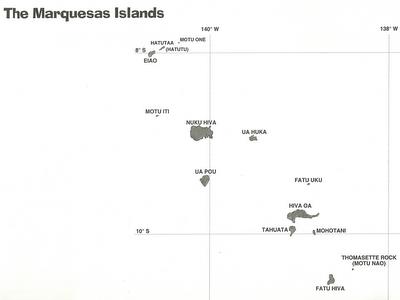 |
Baie Hanavave (Bay of Virgins), Fatu Hiva, Marquesas (June 24-28). Fatu Hiva is the southernmost island in the Marquesas. It has no airstrip, and a total population of about 650 in two villages. The Bay of Virgins with its rocky spires and lush green vegetation is one of the most beautiful anchorages in the world. We're not just saying that because we were so happy to see land after almost 21 days at sea. It really is stunning.
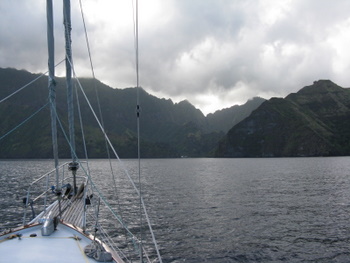 Approaching the anchorage at Fatu Hiva |
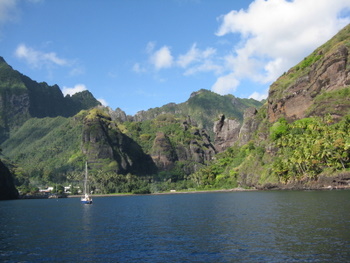 Baie Hanavave (Bay of Virgins) anchorage at Fatu Hiva |
We spent four days in Fatu Hiva, relaxing after our long passage, getting together with friends, swimming in water that was a gorgeous deep blue and hiking on the island. Ben & Annemiek on Blue Penguin (a Dutch boat) arrived the day after us, and that evening, we hosted a get-together on Slip Away with them and Tony & Steven on Endymion (father and son, whom we met in Panama). The next day, we all went ashore and stretched our legs on a hike that took us up a long and winding road to some beautiful views of the bay and valley, and then we trekked through some jungle to the Vai'e'enui waterfall, where we enjoyed a refreshing dip in the pool. The scenery we saw that day was nothing short of spectacular! That evening, we gathered again on Slip Away for a pot-luck dinner. Steven is a hairdresser and had received a nice piece of fish for cutting hair for a local family, so he provided the fish, and we and Blue Penguin provided other side dishes. The next day was Sunday, and we were all invited to attend church in the morning. It was a Catholic mass, which was said in Marquesan. The words were totally unfamiliar, but the ceremony was recognizable. The local ladies all dressed in brightly colored dresses and most wore flowers in their hair, and the feeling was very Polynesian.
|
|
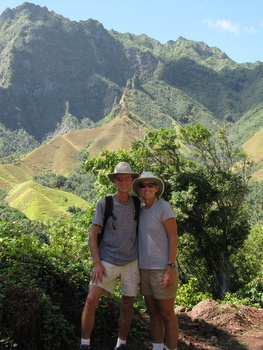 The two of us |
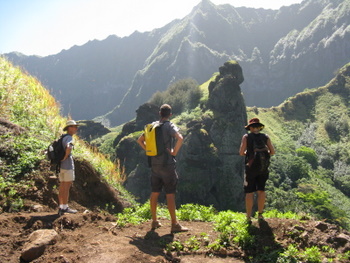 Stunning views on our hike |
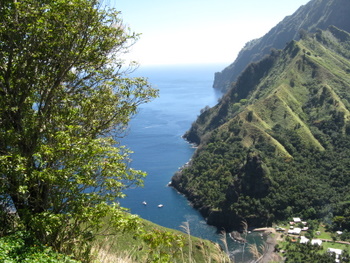 View of the Fatu Hiva anchorage from above |
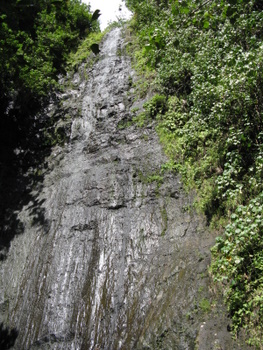 Vai'e'enui Waterfall |
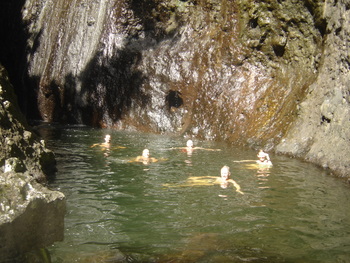 Enjoying a refreshing dip in the waterfall pool |
Atuona, Hiva Oa (June 28-July1). From Fatu Hiva, we sailed north to the town of Atuona on the island of Hiva Oa (48 nm, 10 hours) where we needed to clear in with the authorities (the "Gendarmerie Nationale"). The weather on our passage was squally, and the wind was up and down - sometimes less than 10 knots, and other times gusting up to 25, but we sailed the distance. When we arrived at our destination, we needed to wait outside the harbor while some heavy squalls passed over us, but we finally made it inside and found a spot to anchor. This anchorage can be rolly and uncomfortable, and it's not terribly big and usually crowded, so boats set two anchors (bow and stern) to keep pointed into the swell and to best accommodate everyone.
Hiva Oa is the second largest of the Marquesan Islands. The town of Atuona has a population of about 1,500, and it is the administrative center for the southern cluster of islands. Our check-in with the officials was a piece of cake - we filled out some paperwork, they checked our name off our agent's list for the bond exemption, they stamped our passports, and we were in! The official spoke English and was very pleasant, and in total it took about 15 minutes.
There are a couple of stores (called "magasins") in Atuona with a reasonable selection of groceries, and we bought fresh veggies from a truck parked on the street. The magasins sold baguettes which were baked fresh daily, as well as chocolate croissants ("pain de chocolate") and other pastries, which were quite delicious. As expected, most groceries were pretty expensive (eggs were $4.50 per dozen!), but fortunately, we didn't need a lot. New Zealand butter was reasonably priced at $2.50 per pound, and we found some cans of paté for about $1.50, and that went really well with the baguettes. We had our first meal out in French Polynesia - hamburgers at a little restaurant called "Snack Make Make" recommended by our guide book, but the baguette sandwiches sold at the magasins were much better.
We enjoyed Atuona - it was a charming town and there were some sights to see. Atuona had a couple of famous former residents - artist Paul Gauguin and Belgian singer Jacques Brel. We spent one morning touring the Gauguin Museum, which displayed reproductions of his artwork, and we walked up to the graveyard where both Gauguin and Brel are buried. The graveyard was up on a hill and offered beautiful views of the valley and bay. The town was about a 45 minute walk from the anchorage, but we needed the exercise, and it was a pretty walk past flowering plants, fruit trees and horses grazing in fields.
|
|
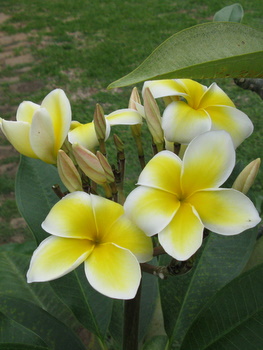 Beautiful flowers in Atuona |
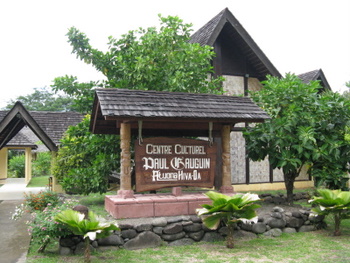 Paul Gauguin Museum |
| Passage from Hiva Oa to Tahuata (July 1, 10 nm, 3 hours). After a couple of days in Atuona, the ocean swell got bigger and the anchorage less comfortable, so we sought out a calmer anchorage on the island of Tahuata, which is just south of Hiva Oa. Tahuata is the smallest of the inhabited islands of the Marquesas, and its total population is only about 650. The tradewinds were blowing fairly strong, and we had to power into them to get out of the bay and to the 2.5 mile wide Canal du Bordelais which separates the islands. All of our cruising guides told us we would normally find a west-flowing current of 2 to 3 knots in this channel, and with the tradewinds blowing from the east, we expected the trip through the channel to be fairly smooth, with a boost from the current. What we encountered was quite different - there was a knot of current running east - against us and also against the tradewinds, which were blowing about 20 knots. Seas were steep, and it was a very rough ride for about an hour. We crossed the channel as quickly as possible and finally found a smoother patch of ocean. It was a short but rough trip. |
|
Baie Hanamoenoa, Tahuata (July 1-4). Baie Hanamoenoa is a wide bay with a white sand beach. We spent a couple of days here, mostly playing in the water. The water was clear, and the snorkeling was good - we saw an octopus, a black-tipped shark and lots of other tropical fish. There are different varieties of fish in the Pacific than in the Caribbean, so there were lots we didn't recognize, and we were trying to memorize some of their characteristics so we could look them up in our fish ID books. We swam to the beach one day but were greeted by some unfriendly dogs, so we passed on our beach walk. We will always fondly remember this anchorage as the "nude" bay. It seemed that none of the cruisers in this bay ever had their clothes on! We celebrated our 11th wedding anniversary here on July 3.
Baie Hanatefau, Tahuata (July 4-5). After a few days at Hanamoenoa, we moved a few miles down the coast of Tahuata to Baie Hanatefau (4.5 nm, 1 hour). There were dolphins playing in the bay when we arrived, and they were usually always in sight, but when we jumped in the water, they kept their distance. We did some more snorkeling here, and also dinghied the short distance to the village of Hapatoni. The small village was picturesque, and the locals were very friendly. We were in search of some fresh fruit, and there was plenty available. We gave the locals some pens, nail polish, lipstick, and even an old pack of cigarettes from Honduras, and we went home with sacks of mangoes, grapefruit (called pamplemousse), guava and a huge stalk of bananas. This was our first taste of the famous French Polynesia pamplemousse, and we were hooked!
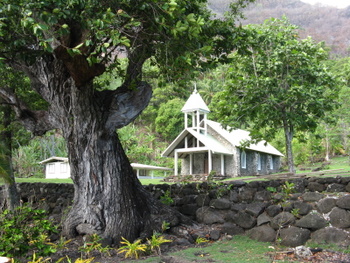 Hapatoni's Catholic Church built in the 1800's |
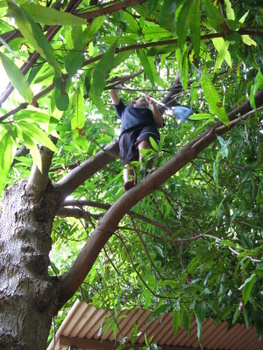 Picking mangoes |
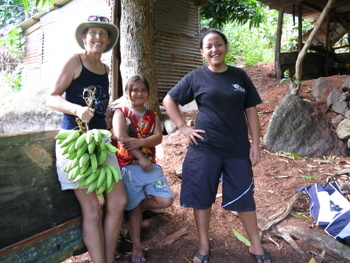 Jan with the girls who helped us gather some fruit |
Passage from Hanatefau Bay, Tahuata to Anaho Bay, Nuku Hiva (July 5-6, 95 nm, 17½ hours). We left Tahuata in the afternoon for an overnight sail north to Nuku Hiva, the largest and most populous of the Marquesan islands. We had about 12-20 knots of wind from the east to northeast for most of the passage, but the seas were lumpy and uncomfortable, and we were happy when we arrived at Anaho Bay the next morning.
Baie d'Anaho, Nuku Hiva (July 6-12). Anaho Bay is a large bay situated on the northern coast of Nuku Hiva, and it's one of the calmest and best protected anchorages in the Marquesas. When we arrived, there were three other boats here, but they all left the following morning, and for the next five days, we had it all to ourselves. For us, the principle attraction here was in the water. Several cruisers told us they swam with manta rays in this bay, and we were hoping to do so, too. We were not disappointed. On two different days, we saw them while snorkeling. Our first day in the water, we found two; they didn't hang around very long, but we were excited to see them. On our second day, we saw one shortly after jumping in the water, and he let us follow him around for about 30 minutes. We would have followed him longer, but we were getting further and further away from our dinghy and decided we should swim back toward it. When we were almost back to our dinghy, we came across a very large spotted eagle ray. He, too, let us follow him around for quite a while as he nuzzled along the coral feeding. On our next couple of snorkeling trips, we went with camera in hand to get photos of these beautiful creatures, but mantas are apparently camera shy and they didn't come around.
We had some very windy and one very rainy day while at Anaho, but this bay was very well protected and quite comfortable in the stormy weather. On the rainy day, we saw a beautiful waterfall running down the side of the mountain that hovers over the anchorage. It was gorgeous! We also had a view of a solar eclipse while in Anaho Bay. We did not experience the total eclipse which occurred a bit further south of us in the Tuamotus, but it was significant in our area, and some passing clouds allowed us to view and photograph it.
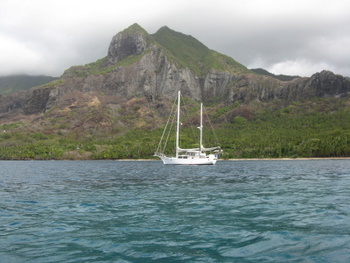 Slip Away Anchored at Anaho Bay |
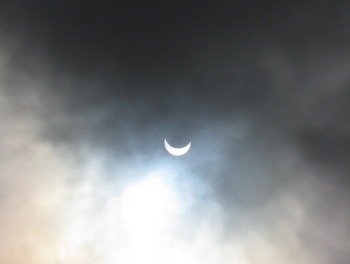 Solar Eclipse |
While in Anaho Bay, we enjoyed the fruits we had gotten in Hapatoni. The pamplemousse were to die for, and the mangoes and bananas were also very sweet. We had a hard time consuming all the bananas when the entire stalk ripened at the same time, so Jan made some banana muffins. We called them our "international muffins" because the ingredients came from several different countries - the flour and sugar from Panama, the eggs were our last ones from the Galapagos, the butter from New Zealand, the salt from Colombia, the vanilla from Mexico, and of course the bananas from the Marquesas.
Baie de Taiohae, Nuku Hiva (July 12-19). From Anaho Bay, we moved on to Taiohae Bay on the southern shore of Nuku Hiva. We left Anaho mid morning, motored a couple of hours to get out of the bay and around the northeast corner of the island, then sailed the rest of the way to Taiohae (29 nm, 6½ hours) with moderate winds (15 knots) but rough and uncomfortable seas.
Taiohae is the largest town (population 1,700) and capital of the Marquesas. Taiohae Bay has a place in history because it was here in 1842 that Herman Melville jumped off from a whaling ship and lived for several months with the Taipi natives in the next bay east of Taiohae. His experiences are chronicled in his book Typee. We didn't have a copy of Typee on board, but after arriving here and hearing about the book, we wanted to read it. We love the new age of technology - we downloaded this book for free on to Rich's Kindle, and we've both now read Melville's interesting tale.
We arrived in Taiohae just in time for the Bastille Day (July 14) celebration. The party started early with a parade in the morning, lots of food and drink and traditional Marquesan dance performances that went into the evening. Bastille Day was the largest day of celebration, but it was actually just one day of the Tahitian Heiva festival, which lasted through the whole month of July in the Marquesas. The Heiva festival has its roots in a pagan celebration of the southern hemisphere solstice. We enjoyed several performances of traditional Marquesan dancing during this time.
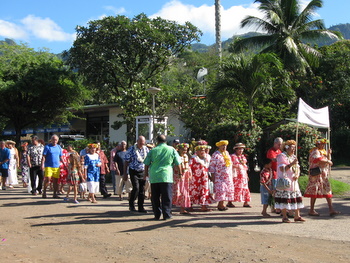 Locals Marching in the Bastille Day Parade |
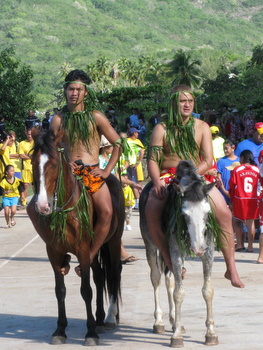 There were a number of beautiful horses in the Bastille Day Parade |
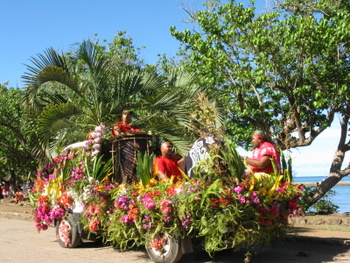 Truck decked out in flowers with musicians in the back |
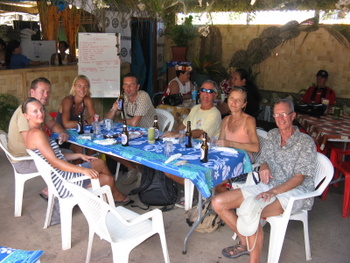 Enjoying a Bastille Day Beer with friends - Clara & Korey (Comfort Zone), Annemiek & Ben (Blue Penguin), Mike & Sue (Infini) and Rich |
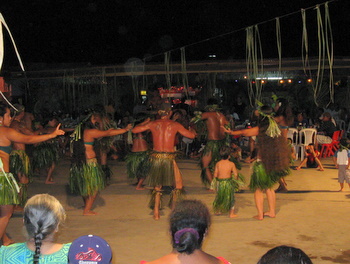 One of the traditional Marquesan dancing performances - those folks can really move their hips! |
Several cruising boats were anchored in Taiohae Bay, and we enjoyed the company of friends while here. The town had a good fruit and veggie market, although one had to get there early (around 5 a.m.) to get the best stuff. We actually did that a few times! Although Rich is not a morning person, he didn't mind getting up for the market because he loved the pastries, and especially the éclairs. Later in the day, one could often find us having lunch at Babazouk, a "roulotte" (or food truck) parked on the waterfront. Babazouk serves great hamburgers every day and roasted chicken on Sundays, and we became friends with the owners, a French couple, Laurent & Laetitia. We also made a few stops at the ice cream "roulotte" near the dinghy dock. At the southwest end of the bay, we visited the small Marquesan museum run by Rose Corser, an American who has lived in the Marquesas for 30 years. She and her late husband cruised to the Marquesas on their sailboat in the 1970's. One Sunday, we attended mass at the Notre Dame Cathedral, with its beautiful wood carvings. We were a little disappointed that the ladies here were not bedecked in flowers and dressed in bright colors like they were in Fatu Hiva - must be the "big city" influence of Taiohae.
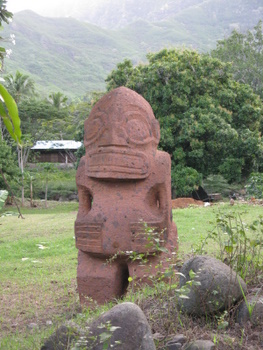 We saw a number of Tikis (stone images of their gods) in these islands |
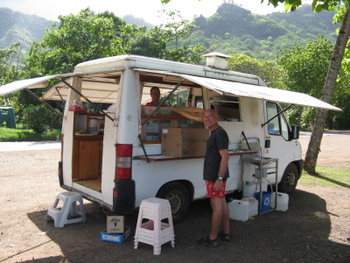 Laetitia & Laurent at the Babazouk roulotte |
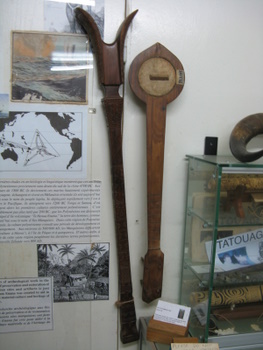 Marquesan artifacts on display at Rose Corser's Museum |
Hakatea Bay, aka Daniels Bay, Nuku Hiva (July 19-23). Hakatea was a short distance from Taiohae (7 nm, 1½ hours), and with the wind on our stern, we sailed most of the way with just a headsail. This bay became famous several years ago when the Survivor TV show filmed on location here. Cruisers often call this Daniels Bay after a very friendly local man named Daniel who lives in this bay. It is our understanding that when Survivor was filmed here, the production company offered to relocate Daniel and bought him a very nice house in Taiohae. Daniel has since moved back to Hakatea.
The day after we arrived in Hakatea, we hiked with our friends Mike and Sue on Infini to the Vaipo waterfall, which with a 2,000 foot drop (610 meters) is reputed to be the third highest in the world. There hadn't been much rain lately, so there wasn't much water flowing down the falls, but the hike to and from it was beautiful, and we enjoyed a cool swim in the pool. We also visited and did some trading for fruits with Mai and Maria, a very nice Marquesan couple who are very welcoming to cruisers.
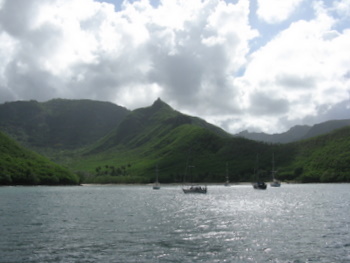 Hakatea (Daniels Bay) Anchorage |
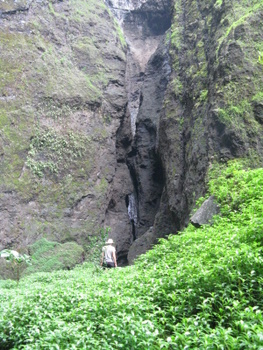 Hike to the Vaipo Waterfall |
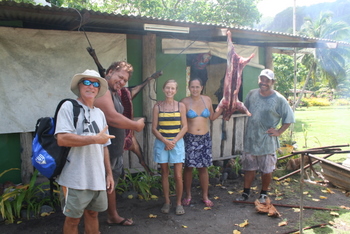 Mike & Sue on Infini with locals Gustav, Maria & Mai with two goats they got from their hunting trip |
We expected the water in Hakatea Bay to be clearer than in Taiohae, so we also wanted to clean our boat bottom here in preparation for our passage to the Tuamotus, which we planned to make in the next few days. Visibility wasn't great, but we got the bottom scrubbed in spite of it.
Taiohae Bay, Nuku Hiva (July 23 - August 5). After a few days at Hakatea, we motored back to Taiohae for some final preparations before our departure to the Tuamotus. We expected the trip back to Taiohae to be rough since we were motoring into the wind and seas, but we were pleasantly surprised by fairly calm conditions.
The first item on our to-do list upon our return to Taiohae was for both of us to get a tattoo. Tattooing has long been a tradition in the Marquesas, and several of our friends had gotten tattooed by a highly recommended local artist named Brise. Long before our arrival in Marquesas, we had discussed getting a tattoo as a permanent souvenir of our South Pacific journey. We decided this was the place to do it. We chose our designs, made our appointment, and Brise did the job quickly and with a minimal amount of pain. Brise works from his home and lives with his mother Bernadette, a lovely woman who always sent us home with bags of fruits - mangoes, passion fruits and avocados.
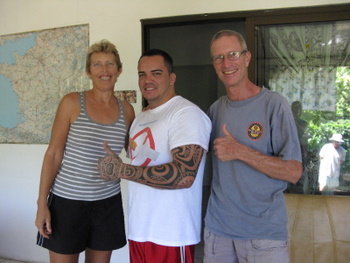 Two of us with tattoo artist Brise |
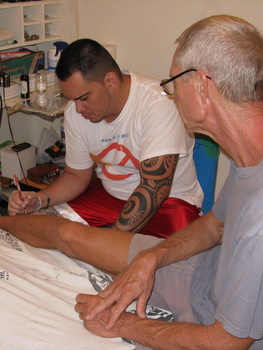 Brise working on Rich's tattoo |
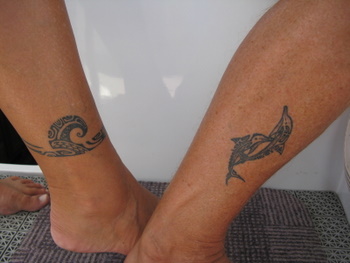 The finished artwork |
After getting our tattoos, we planned to hang out a few days to make sure they were healing with no problems, and then we would purchase a few provisions and be on our way to the Tuamotus. However, after a look at the weather, we were in no hurry to move on. The forecast called for "reinforced tradewinds", which basically meant it was going to be blowing like stink. Although we were benefiting from the cooler weather in the Marquesas at this time of year, July is also the month when the tradewinds blow the hardest. One boat decided to go ahead to the Tuamotus and reported wind speeds of 30-40 knots and 5-6 meter seas - no thank you! Although the winds were howling outside, we were tucked snugly into Taiohae Bay, and we weren't going anywhere.
We ended up staying in Taiohae about ten days longer than anticipated, but we didn't mind at all. There is exceptional hiking all around this bay, and we found some great treks. One morning, we hiked out to the southeast end of the bay, where we enjoyed beautiful views of the entire bay and could even see manta rays playing in the water. Another day, we hiked southwest and over a hill to another smaller bay where we found a local guy swimming with his horse. On the way back from that hike, we treated ourselves to a nice lunch at the Keikahanui / Pearl Lodge Hotel. The ambiance was wonderful, we enjoyed a fabulous meal (tuna sashimi for Jan and poisson cru for Rich), and it wasn't terribly expensive. After a rainy day, we hiked to another beautiful waterfall.
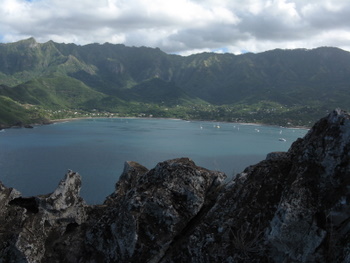 View of Taiohae from the southeast end of the bay |
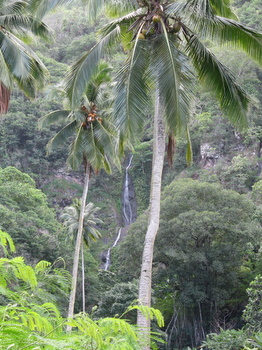 Another beautiful waterfall |
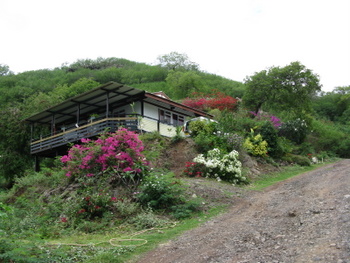 Marquesan homes were modest but tidy, and most had beautiful plantings in their yards |
|
|
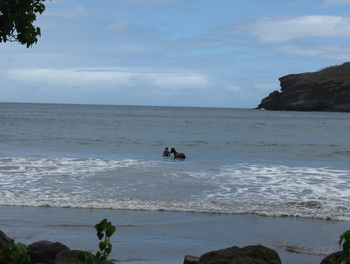 Local guy swimming with his horse at the bay over the hill at the southwest end of Taiohae |
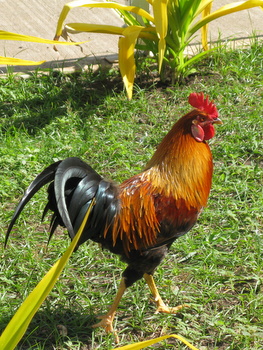 There were lots of roosters and chickens roaming around the Marquesas. The roosters were some of the prettiest we've ever seen. |
The winds finally calmed down, and we prepared for departure. We went into the veggie market to pick up a few last items and got there late (8:30 a.m.). Most of the good stuff was gone, but our friend Karin (Rich's éclair supplier) saved some tomatoes and zucchini for us - how thoughtful! Laurent & Laetitia had also arranged to get us some lettuce, cucumber and tomatoes from their veggie supply person, so we were well taken care of by our local friends.
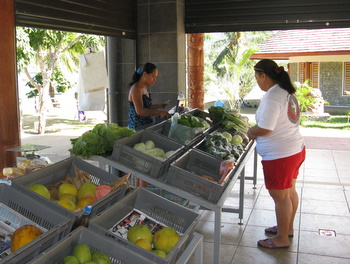 Slim pickings at the market after the sun comes up! |
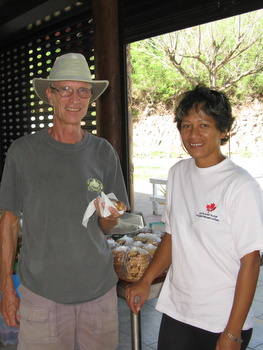 Rich and Karin who sold wonderful éclairs |
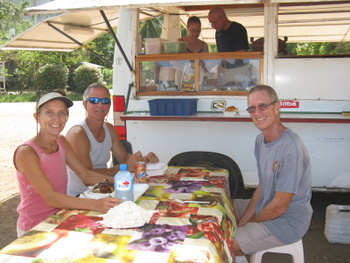 Lunch at Babazouk with Sue & Mike from Infini |
We departed Taiohae Bay and the Marquesas Islands on August 5, headed for the Tuamotu Archipelago, 500 miles away. The Marquesas Islands were a wonderful first stop in French Polynesia, and after our visit there, we were certain we wanted to take our time exploring French Polynesia.
